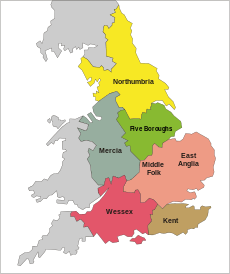Ealdorman
 |
| Cyning (sovereign) |
| Ætheling (prince) |
| Ealdorman (prefect) |
| High-reeve |
| Reeve (bailiff) |
| Thegn/Housecarl (retainer) |
| Churl (free tenant) |
| Villein (serf) |
| Cottar (cottager) |
| Góp (slave) |
An ealdorman (from Old English ealdorman, lit. "elder man"; plural: "ealdormen") was a high-ranking royal official and prior magistrate of an Anglo-Saxon shire or group of shires from about the ninth century to the time of King Cnut. The term "ealdorman" was rendered in Latin as dux in early West Saxon charters, and as præfectus (which is also the equivalent of gerefa, modern reeve, from which sheriff or shire reeve is derived). In the Life of King Alfred by the Welsh bishop Asser, the Latin equivalent is comes.[1] As the chief magistrate of a shire or group of shires (county) in Anglo-Saxon England, the ealdorman commanded the army of the shire(s) and districts under his control on behalf of the king.
Appointment
.jpg)
Ealdormen were appointees of the king and were originally mostly from the ancient and powerful families, but later were often chosen from among the king's comites (plural of comes, lit. "companion") and many, especially in the early Danish period, were new to high office. When smaller kingdoms such as Sussex and Essex were absorbed within a larger one, e.g. Wessex, the former ruling family seems to have been suffered a diminution of their title from "King" or "Sub-King" to Eorldorman. Presumably this office would have initially been hereditary among the former royal family but in later Anglo-Saxon times the office was clearly not hereditary or where it was this was exceptional. There are several examples of tenth-century ealdormen whose sons became ealdormen (if not always of the same district), such as Æthelstan Half-King and Æthelweard the Chronicler.
Earls
Towards the end of the tenth century, the term ealdorman gradually disappeared as it gave way to eorl, possibly under the influence of the Danish term jarl, which may then have evolved into the English earl. The analogous term is sometimes count, from the French comte, derived from the Latin comes. The ealdormen can be thought of as the early English earls, for their ealdormanries (singular ealdormanry, same meaning as earldom) eventually became the great earldoms of Anglo-Danish and Anglo-Norman England.
An ealdormancy was an Anglo-Saxon governing body over several shires, made up of more than one ealdorman.
Aldermen
Although earls may be regarded as the successors of ealdormen, the word ealdorman itself did not disappear and survives in modern times as alderman. This term, however, developed distinctly different meanings which have little to do with ealdormen, who ruled shires or larger areas, while aldermen are members of a municipal assembly or council.
See also
- Earls, ealdormen and high-reeves of Bamburgh
- Æthelmund, Ealdorman of the Hwicce
- Ælfhere, ealdorman of Mercia (d. 983)
- Ælfhelm, ealdorman of southern Northumbria (d. c. 1006)
- Ælfric, ealdorman of Hampshire
- Æthelweard the Chronicler
- Byrhtnoth, ealdorman of Essex (d. 991)
- Eadric Streona, ealdorman of the Mercians (d. 1017)
- Odda, Ealdorman of Devon (fl. 878)
- Wulfstan, ealdorman of Wiltshire (d.802)
Notes
- ↑ David A. E. Pelteret, The Earldormen of Alfred's Reign.
References
- Pelteret, David A. E., [The Earldormen of Alfred’s Reign], Revised version of a paper presented at the First Session of the International Medieval Congress, University of Leeds, on 12 July 2004
Further reading
- Banton, N., "Ealdormen and Earls in England from the Reign of King Alfred to the Reign of King Æthelred II", D.Phil. thesis, University of Oxford, 1981
- Loyn, Henry R. "The term ealdorman in the translations prepared at the time of King Alfred." English Historical Review 68 (1953): 513-25.
- Stenton, Sir Frank M. Anglo-Saxon England; 3rd ed. London: Oxford University Press, 1971.
- Williams, Ann. Kingship and Government in Pre-Conquest England, c.500–1066. Basingstoke: Macmillan, 1999 ISBN 0-333-56797-8